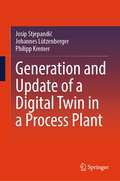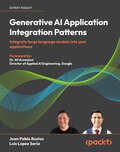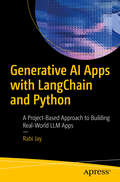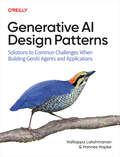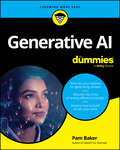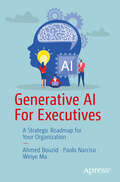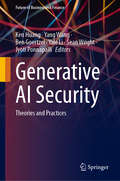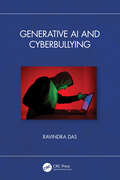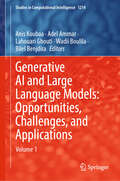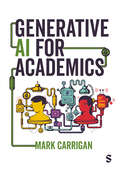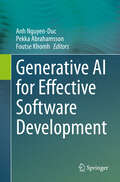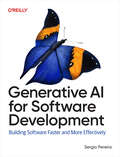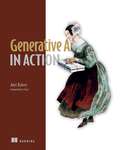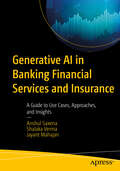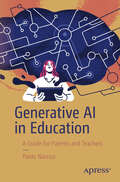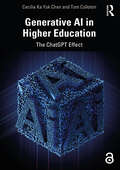- Table View
- List View
Generation and Update of a Digital Twin in a Process Plant
by Josip Stjepandić Johannes Lützenberger Philipp KremerThis book covers the most important subjects of digital twin in a process plant, including foundations, methods, achievements, and applications in a brownfield environment. Besides offering a variety of applications and procedural variants from research and industrial practice, this book also provides a comprehensive insight into holistic plant planning. It also discusses the challenges that currently exist in different application areas. This book would be of interest to industry professionals and researchers in industrial and manufacturing engineering.
Generative AI Application Integration Patterns: Integrate large language models into your applications
by Juan Pablo Bustos Luis Lopez SoriaUnleash the transformative potential of GenAI with this comprehensive guide that serves as an indispensable roadmap for integrating large language models into real-world applications. Gain invaluable insights into identifying compelling use cases, leveraging state-of-the-art models effectively, deploying these models into your applications at scale, and navigating ethical considerations.Key FeaturesGet familiar with the most important tools and concepts used in real scenarios to design GenAI appsInteract with GenAI models to tailor model behavior to minimize hallucinationsGet acquainted with a variety of strategies and an easy to follow 4 step frameworks for integrating GenAI into applicationsBook DescriptionExplore the transformative potential of GenAI in the application development lifecycle. Through concrete examples, you will go through the process of ideation and integration, understanding the tradeoffs and the decision points when integrating GenAI. With recent advances in models like Google Gemini, Anthropic Claude, DALL-E and GPT-4o, this timely resource will help you harness these technologies through proven design patterns. We then delve into the practical applications of GenAI, identifying common use cases and applying design patterns to address real-world challenges. From summarization and metadata extraction to intent classification and question answering, each chapter offers practical examples and blueprints for leveraging GenAI across diverse domains and tasks. You will learn how to fine-tune models for specific applications, progressing from basic prompting to sophisticated strategies such as retrieval augmented generation (RAG) and chain of thought. Additionally, we provide end-to-end guidance on operationalizing models, including data prep, training, deployment, and monitoring. We also focus on responsible and ethical development techniques for transparency, auditing, and governance as crucial design patterns.What you will learnConcepts of GenAI: pre-training, fine-tuning, prompt engineering, and RAGFramework for integrating AI: entry points, prompt pre-processing, inference, post-processing, and presentationPatterns for batch and real-time integrationCode samples for metadata extraction, summarization, intent classification, question-answering with RAG, and moreEthical use: bias mitigation, data privacy, and monitoringDeployment and hosting options for GenAI modelsWho this book is forThis book is not an introduction to AI/ML or Python. It offers practical guides for designing, building, and deploying GenAI applications in production. While all readers are welcome, those who benefit most include: Developer engineers with foundational tech knowledge Software architects seeking best practices and design patterns Professionals using ML for data science, research, etc., who want a deeper understanding of Generative AI Technical product managers with a software development background This concise focus ensures practical, actionable insights for experienced professionals
Generative AI Apps with LangChain and Python: A Project-Based Approach to Building Real-World LLM Apps
by Rabi JayFuture-proof your programming career through practical projects designed to grasp the intricacies of LangChain’s components, from core chains to advanced conversational agents. This hands-on book provides Python developers with the necessary skills to develop real-world Large Language Model (LLM)-based Generative AI applications quickly, regardless of their experience level. Projects throughout the book offer practical LLM solutions for common business issues, such as information overload, internal knowledge access, and enhanced customer communication. Meanwhile, you’ll learn how to optimize workflows, enhance embedding efficiency, select between vector stores, and other optimizations relevant to experienced AI users. The emphasis on real-world applications and practical examples will enable you to customize your own projects to address pain points across various industries. Developing LangChain-based Generative AI LLM Apps with Python employs a focused toolkit (LangChain, Pinecone, and Streamlit LLM integration) to practically showcase how Python developers can leverage existing skills to build Generative AI solutions. By addressing tangible challenges, you’ll learn-by-be doing, enhancing your career possibilities in today’s rapidly evolving landscape. What You Will Learn Understand different types of LLMs and how to select the right ones for responsible AI. Structure effective prompts. Master LangChain concepts, such as chains, models, memory, and agents. Apply embeddings effectively for search, content comparison, and understanding similarity. Setup and integrate Pinecone vector database for indexing, structuring data, and search. Build Q & A applications for multiple doc formats. Develop multi-step AI workflow apps using LangChain agents. Who This Book Is For Python programmers who aim to develop a basic understanding of AI concepts and move from LLM theory to practical Generative AI application development using LangChain; those seeking a structured guide to enhance their careers by learning to create robust, real-world LLM-powered Generative AI applications; data scientists, analysts, and experienced developers new to LLMs.
Generative AI Design Patterns: Solutions to Common Challenges When Building GenAI Agents and Applications
by Valliappa Lakshmanan Hannes HapkeGenerative AI enables powerful new capabilities, but they come with some serious limitations that you'll have to tackle to ship a reliable application or agent. Luckily, experts in the field have compiled a library of 32 tried-and-true design patterns to address the challenges you're likely to encounter when building applications using LLMs, such as hallucinations, nondeterministic responses, and knowledge cutoffs. This book codifies research and real-world experience into advice you can incorporate into your projects. Each pattern describes a problem, shows a proven way to solve it with a fully coded example, and discusses trade-offs. Design around the limitations of LLMs Ensure that generated content follows a specific style, tone, or format Maximize creativity while balancing different types of risk Build agents that plan, self-correct, take action, and collaborate with other agents Compose patterns into agentic applications for a variety of use cases
Generative AI Engineering: Build apps with transformer and diffusion-based large and foundational models
by Konrad BanachewiczApply creativity and engineering to create apps with transformer and diffusion based large and foundational models Purchase of the print or Kindle book includes a free PDF eBookKey FeaturesLearn with practical examples, code snippets, and use cases from a variety of generative AI applicationsConquer the core concepts and techniques of generative AI engineeringGet to grips with productionizing operational pipelines with generative AIBook DescriptionGenerative AI Engineering is a hands-on guide to utilizing generative AI for creating advanced AI based applications. It’s designed for both beginners and experienced practitioners who want to learn how to develop generative AI models-based applications and use them to solve real-world problems. As you progress through the chapters, you’ll cover all the core concepts and techniques of generative AI engineering, including transformer and diffusion-based models. You'll also learn from practical examples and carefully chosen code snippets that will help you understand how to apply these concepts to real-world problems. You will learn the generative AI services and platforms offered by major cloud providers, GCP, AWS, and Microsoft Azure. With its comprehensive coverage and practical examples, this book will provide you with the skills and knowledge you need to build cutting-edge AI applications that can create new content, generate realistic images and videos, and solve complex problems in a wide range of industries.What you will learnGet to grips with the fundamentals of generative AI and its applicationsFamiliarize yourself with different types of generative models and when to use themTrain and Finetune generative models using PyTorchEvaluate the performance of your models and fine-tune them for optimal resultsFind best practices for deploying and scaling generative AI models in production environmentsWho this book is forWhether you are a software engineer, data scientist, or AI enthusiast, Generative AI Engineering is an essential resource that will help you master the art of building generative AI models. To get started, you’ll need to have basic knowledge of Python coding, including Jupyter Notebooks, setup cloud or local infrastructure using Docker containers for sample code, and deep learning and PyTorch.
Generative AI For Dummies
by Pam BakerGenerate a personal assistant with generative AI Generative AI tools capable of creating text, images, and even ideas seemingly out of thin air have exploded in popularity and sophistication. This valuable technology can assist in authoring short and long-form content, producing audio and video, serving as a research assistant, and tons of other professional and personal tasks. Generative AI For Dummies is your roadmap to using the world of artificial intelligence to enhance your personal and professional lives. You'll learn how to identify the best platforms for your needs and write the prompts that coax out the content you want. Written by the best-selling author of ChatGPT For Dummies, this book is the ideal place to start when you're ready to fully dive into the world of generative AI. Discover the best generative AI tools and learn how to use them for writing, designing, and beyond Write strong AI prompts so you can generate valuable output and save time Create AI-generated audio, video, and imagery Incorporate AI into your everyday tasks for enhanced productivity This book offers an easy-to-follow overview of the capabilities of generative AI and how to incorporate them into any job. It's perfect for anyone who wants to add AI know-how into their work.
Generative AI For Executives: A Strategic Roadmap for Your Organization
by Ahmed Bouzid Weiye Ma Paolo NarcisoIn the fast-evolving digital landscape, understanding the potential of generative AI is a strategic advantage. This book can serve as an easy to read introduction to the topic of the transformative power of AI in content creation, customer engagement, and operational efficiency. By deciphering complex AI concepts into practical insights, we empower decision-makers to envision innovative strategies, foster cross-industry collaborations, and navigate ethical considerations. The book will help executives and business decision makers to harness the immense potential of generative AI responsibly, ensuring data integrity and compliance while fostering a competitive edge. The book is focused on (1) Explaining in jargon-free language what Generative AI, and AI in general, (2) What problems they solve, and (3) What technologies make them possible.What You Will LearnHow generative AI models are built, how they generate new data or content, and the underlying algorithms powering these processesVarious practical applications of generative AI in business contextsThe challenges that could arise during the integration of generative AI into business processesWho This Book is ForThis book is meant to be bought and read by busy executives and business leaders
Generative AI Security: Theories and Practices (Future of Business and Finance)
by Sean Wright Ben Goertzel Yang Wang Ken Huang Yale Li Jyoti PonnapalliThis book explores the revolutionary intersection of Generative AI (GenAI) and cybersecurity. It presents a comprehensive guide that intertwines theories and practices, aiming to equip cybersecurity professionals, CISOs, AI researchers, developers, architects and college students with an understanding of GenAI’s profound impacts on cybersecurity. The scope of the book ranges from the foundations of GenAI, including underlying principles, advanced architectures, and cutting-edge research, to specific aspects of GenAI security such as data security, model security, application-level security, and the emerging fields of LLMOps and DevSecOps. It explores AI regulations around the globe, ethical considerations, the threat landscape, and privacy preservation. Further, it assesses the transformative potential of GenAI in reshaping the cybersecurity landscape, the ethical implications of using advanced models, and the innovative strategies required to secure GenAI applications. Lastly, the book presents an in-depth analysis of the security challenges and potential solutions specific to GenAI, and a forward-looking view of how it can redefine cybersecurity practices. By addressing these topics, it provides answers to questions on how to secure GenAI applications, as well as vital support with understanding and navigating the complex and ever-evolving regulatory environments, and how to build a resilient GenAI security program. The book offers actionable insights and hands-on resources for anyone engaged in the rapidly evolving world of GenAI and cybersecurity.
Generative AI and Cyberbullying
by Ravindra DasEver since the COVID-19 pandemic occurred in 2020, the world has transformed itself greatly. For example, not only is the near-99% remote workforce now a reality, but businesses today are taking incident response and disaster recovery much more seriously these days as well. But another area that has blossomed in the last couple of years has been that of Generative AI. It is actually a subfield of artificial intelligence, which has been around since the 1950s.But Gen AI (as it is also called) has been fueled by the technology of ChatGPT, which has been developed and created by OpenAI. Given the GPT4 algorithms Gen AI is powered by, an end user can merely type in, or even speak into the platform a query, and an output that is specific to that query will be automatically generated. The answer (or "output") can be given as a text, video, image, or even an audio file.The scalability and diversity of Gen AI has allowed it to be used in a myriad of industries and applications. But although it has been primarily designed to serve the greater good, it can also be used for very nefarious purposes, such as online harassment and Cyberbullying.In this particular book, we actually take the good side of Gen AI and provide an overview as to how it can be used to help combat Cyberbullying. This book is broken down into the following topics: What Cyberbullying is all about How Gen AI can be used to combat Cyberbullying An overview into Gen AI Advanced topics into Gen AI Conclusions
Generative AI and Digital Forensics
by Ravindra DasIn today’s world, cybersecurity attacks and security breaches are becoming the norm. Unfortunately, we are not immune to it, and any individual and entity is at dire risk. The best and only thing that we can do is to mitigate the risks as much as much as possible so that they do not happen at all. But even when a security breach does indeed happen, the immediate reaction is to contain it so that it does not penetrate further into the information technology/network infrastructure. From there, mission-critical processes need to be restored, until the business can resume a normal state of operations, like it was before the security breach.But another key step here is to investigate how and why the security breach happened in the first place. The best way to do this is through what is known as “digital forensics”. This is where specially trained digital forensics investigators collect and comb through every piece of evidence to determine this. Eventually, the goal is then to use this evidence in a court of law so the cyberattacker can be made to answer for their crime and eventually be brought to justice.However, the area of digital forensics is a large one, and many topics around it can be covered. Also, generative AI is being used to not only help in the analysis of the evidence but also to help automate the digital forensics software packages that are available today. Therefore, in this book, the following is covered: Examples of security breaches and overview of digital forensics. How digital forensics can be used to investigate the loss or theft of data. An introduction to the SQL Server Database. A review of the SQL Injection Attack. How generative AI can be used in digital forensics.
Generative AI and Large Language Models: Volume 1 (Studies in Computational Intelligence #1214)
by Anis Koubaa Adel Ammar Wadii Boulila Lahouari Ghouti Bilel BenjdiraThis book provides a comprehensive exploration of the transformative impact of AI technologies across diverse fields. From revolutionizing healthcare diagnostics and advancing natural language processing for low-resource languages to enhancing software development and promoting environmental sustainability, this book explores the cutting-edge advancements and practical applications of generative AI and large language models (LLMs). With a focus on both opportunities and challenges, the book examines the architectural challenges of transformer-based models, the ethical implications of AI, and the importance of language-specific adaptations, particularly for low-resource languages like Arabic. It also highlights the role of AI in code development, multimodal applications, and its integration with intellectual property frameworks. This book is an essential resource for researchers, practitioners, and policymakers seeking to understand and harness the potential of AI to drive innovation and global progress.
Generative AI for Academics
by Mark CarriganThis is your indispensable guide to navigating the rise of generative AI as an academic. It thoughtfully explores rapidly evolving AI capabilities reshaping higher education, examining challenges and ethical dilemmas across the sector. It provides useful strategies for using generative AI in your scholarly work while upholding professional standards. This practical guidance addresses four core areas of academic work: Thinking: How to use generative AI to augment individual and collaborative scholarly thinking that can assist in developing novel ideas and advancing impactful projects Collaborating: Explore how generative AI can be used as a research assistant, coordinating teams and enhancing scholarly cooperation Communicating: Cautioning against over-reliance, examine how generative AI can relieve communication burdens while maintaining professionalism and etiquette Engaging: thoughtful and practical frameworks are offered for using these developments to support online engagement without sacrificing scholarly principles Mark Carrigan is a digital sociologist, author and Lecturer in Education at the University of Manchester.
Generative AI for Academics
by Mark CarriganThis is your indispensable guide to navigating the rise of generative AI as an academic. It thoughtfully explores rapidly evolving AI capabilities reshaping higher education, examining challenges and ethical dilemmas across the sector. It provides useful strategies for using generative AI in your scholarly work while upholding professional standards. This practical guidance addresses four core areas of academic work: Thinking: How to use generative AI to augment individual and collaborative scholarly thinking that can assist in developing novel ideas and advancing impactful projects Collaborating: Explore how generative AI can be used as a research assistant, coordinating teams and enhancing scholarly cooperation Communicating: Cautioning against over-reliance, examine how generative AI can relieve communication burdens while maintaining professionalism and etiquette Engaging: thoughtful and practical frameworks are offered for using these developments to support online engagement without sacrificing scholarly principles Mark Carrigan is a digital sociologist, author and Lecturer in Education at the University of Manchester.
Generative AI for Effective Software Development
by Pekka Abrahamsson Anh Nguyen-Duc Foutse KhomhThis book provides a comprehensive, empirically grounded exploration of how Generative AI is reshaping the landscape of software development. It emphasizes the empirical evaluation of Generative AI tools in real-world scenarios, offering insights into their practical efficacy, limitations, and impact. By presenting case studies, surveys, and interviews from various software development contexts, the book offers a global perspective on the integration of Generative AI, highlighting how these advanced tools are adapted to and influence diverse cultural, organizational, and technological environments. This book is structured to provide a comprehensive understanding of Generative AI and its transformative impact on the field of software engineering. The book is divided into five parts, each focusing on different aspects of Generative AI in software development. As an introduction, Part 1 presents the fundamentals of Generative AI adoption. Part 2 is a collection of empirical studies and delves into the practical aspects of integrating Generative AI tools in software engineering, with a focus on patterns, methodologies, and comparative analyses. Next, Part 3 presents case studies that showcase the application and impact of Generative AI in various software development contexts. Part 4 then examines how Generative AI is reshaping software engineering processes, from collaboration and workflow to management and agile development. Finally, Part 5 looks towards the future, exploring emerging trends, future directions, and the role of education in the context of Generative AI. The book offers diverse perspectives as it compiles research and experiences from various countries and software development environments. It also offers non-technical discussions about Generative AI in management, teamwork, business and education. This way, it is intended for both researchers in software engineering and for professionals in industry who want to learn about the impactof Generative AI on software development.
Generative AI for Software Development: Building Software Faster and More Effectively
by Sergio PereiraIn just a few short years, AI has transformed software development, and snazzy new tools continue to arrive, with no let-up in sight. How, as a software engineer, product builder, or CTO, do you keep up? This practical book is the result of Sergio Pereira's mission to test every AI tool he could find and provide practitioners with much-needed guidance through the commotion. Generative AI for Software Development focuses on AI tool comparisons, practical workflows, and real-world case studies, with each chapter encompassing critical evaluations of the tools, their use cases, and their limitations. While product reviews are always relevant, the book goes further and delivers to readers a coherent framework for evaluating the tools and workflows of the future, which will continue to complicate the work of software development. Learn how code generation and autocompletion assistants are reshaping the developer experience Discover a consistent method for rating code-generation tools based on real-world coding challenges Explore the GenAI tools transforming UI/UX design and frontend development Learn how AI is streamlining code reviews and bug detection Review tools that are simplifying software testing and QA Explore AI for documentation and technical writing Understand how modern LLMs have redefined what chatbots can do
Generative AI for Web Development: Building Web Applications Powered by OpenAI APIs and Next.js
by Tom Auger Emma SaroyanExplore the world of Generative AI and understand why it matters. This book is divided into two parts, introducing tools such as ChatGPT, DALL-E, and will show you how to use them to build AI-powered web apps. The first part of the book describes Generative AI and covers the essential models and APIs from OpenAI. Legal, ethical, and security considerations are discussed to help you decide whether it is an appropriate tool for your projects. You’ll then review ChatGPT and see how to use it effectively for generating code. This is followed by a review of best practices, and tips and techniques for getting around the limitations of ChatGPT and other OpenAI APIs. The second part of the book provides practical guide to building a series of web apps with Next.js that showcase how to use the OpenAI APIs. For example, you’ll learn how to build a Story/Poetry generator, a language learning app, and a blog site with a custom Chatbot widget. The code for the web apps is generated using ChatGPT. When done with this book, you’ll have a clear understanding of Generative AI and be well on your way to building web applications powered by OpenAI APIs and Next.js. What You Will Learn Assess the legal, ethical, and security concerns with using Generative AI in web applications Review the latest APIs provided by OpenAI for generating text and image Use ChatGPT to generate code for web projects, as well as tips and tricks to working around the limitations. Who This Book Is For Experienced web developers and software engineers who know their way around HTML, CSS, and JavaScript, but have limited or no experience using Generative AI to build web applications.
Generative AI for a Net-Zero Economy: Managing Climate Change and Business Innovation in the Digital Era
by Subhankar Das Subhra R. Mondal Lukas VartiakThis book covers the technological aspects of Generative AI, its applications in achieving a net-zero carbon economy, the challenges of climate change, and the economic and management implications of these transitions. The book explores the transformative potential of Generative AI in driving the transition to a net-zero economy. It examines how this cutting-edge technology is revolutionizing climate change mitigation strategies and reshaping business models in the digital age. The book offers a comprehensive guide to leveraging AI for sustainable innovation through case studies, expert insights, and forward-thinking analysis. It addresses the challenges and opportunities in integrating AI into climate action plans, economic policies, and corporate strategies. Essential reading for policymakers, business leaders, and technologists, this book provides a roadmap for harnessing Generative AI to create a sustainable, prosperous future encompassing several key elements that align with the United Nations Sustainable Development Goals, in particular SDG 13: Climate Action.
Generative AI for the Medical Student: Core Concepts to Clinical Practice
by Campion QuinnThis book provides medical students with a practical, non‐technical roadmap for understanding, applying, and leading generative AI in clinical practice. Despite explosive interest in AI, there is no accessible, clinically focused primer tailored to medical students without programming backgrounds. Educators and students need a resource that translates theory into actionable skills, crafting effective prompts, interpreting AI outputs, embedding tools into workflows, and upholding ethical and legal standards. By filling this gap, the book equips future physicians to use AI confidently and safely at the bedside and in documentation, lead pilot projects and quality-improvement initiatives, navigate certification, research, and career development in digital health. In short, it transforms generative AI from a black-box novelty into a dependable clinical partner, fulfilling a critical educational need at the intersection of medicine and technology. The text begins by demystifying core AI concepts, transformers, self‐attention, NLP, CNNs, and Retrieval‐Augmented Generation. It then moves through hands‐on chapters on securing stakeholder buy-in, prompt engineering, error management, and quality-improvement cycles. A capstone &“AI Journal Club&” and simulation exercises reinforce learning in real-world vignettes, while later chapters guide students through ethics, research, collaboration, career pathways, and a SMART-goal–driven lifelong learning plan. This is an ideal guide for all medical students interested in integrating generative AI into their career.
Generative AI in Action (In Action)
by Amit BahreeGenerative AI can transform your business by streamlining the process of creating text, images, and code. This book will show you how to get in on the action!Generative AI in Action is the comprehensive and concrete guide to generative AI you&’ve been searching for. It introduces both AI&’s fundamental principles and its practical applications in an enterprise context—from generating text and images for product catalogs and marketing campaigns, to technical reporting, and even writing software. Inside, author Amit Bahree shares his experience leading Generative AI projects at Microsoft for nearly a decade, starting well before the current GPT revolution. Inside Generative AI in Action you will find: • A practical overview of of generative AI applications • Architectural patterns, integration guidance, and best practices for generative AI • The latest techniques like RAG, prompt engineering, and multi-modality • The challenges and risks of generative AI like hallucinations and jailbreaks • How to integrate generative AI into your business and IT strategy Generative AI in Action is full of real-world use cases for generative AI, showing you where and how to start integrating this powerful technology into your products and workflows. You&’ll benefit from tried-and-tested implementation advice, as well as application architectures to deploy GenAI in production at enterprise scale. About the technology In controlled environments, deep learning systems routinely surpass humans in reading comprehension, image recognition, and language understanding. Large Language Models (LLMs) can deliver similar results in text and image generation and predictive reasoning. Outside the lab, though, generative AI can both impress and fail spectacularly. So how do you get the results you want? Keep reading! About the book Generative AI in Action presents concrete examples, insights, and techniques for using LLMs and other modern AI technologies successfully and safely. In it, you&’ll find practical approaches for incorporating AI into marketing, software development, business report generation, data storytelling, and other typically-human tasks. You&’ll explore the emerging patterns for GenAI apps, master best practices for prompt engineering, and learn how to address hallucination, high operating costs, the rapid pace of change and other common problems. What's inside • Best practices for deploying Generative AI apps • Production-quality RAG • Adapting GenAI models to your specific domain About the reader For enterprise architects, developers, and data scientists interested in upgrading their architectures with generative AI. About the author Amit Bahree is Principal Group Product Manager for the Azure AI engineering team at Microsoft. The technical editor on this book was Wee Hyong Tok. Table of Contents Part 1 1 Introduction to generative AI 2 Introduction to large language models 3 Working through an API: Generating text 4 From pixels to pictures: Generating images 5 What else can AI generate? Part 2 6 Guide to prompt engineering 7 Retrieval-augmented generation: The secret weapon 8 Chatting with your data 9 Tailoring models with model adaptation and fine-tuning Part 3 10 Application architecture for generative AI apps 11 Scaling up: Best practices for production deployment 12 Evaluations and benchmarks 13 Guide to ethical GenAI: Principles, practices, and pitfalls A The book&’s GitHub repository B Responsible AI tools
Generative AI in Banking Financial Services and Insurance: A Guide to Use Cases, Approaches, and Insights
by Anshul Saxena Shalaka Verma Jayant MahajanThis book explores the integration of Generative AI within the Banking, Financial Services, and Insurance (BFSI) sector, elucidating its implications, applications, and the future landscape of BFSI. The first part delves into the origins and evolution of Generative AI, providing insights into its mechanics and applications within the BFSI context. It goes into the core technologies behind Generative AI, emphasizing their significance and practical applications. The second part explores how Generative AI intersects with core banking processes, ranging from transactional activities to customer support, credit assessment, and regulatory compliance. It focuses on the digital transformation driving investment banking into the future. It also discusses AI’s role in algorithmic trading, client interactions, and regulatory adaptations. It analyzes AI-driven techniques in portfolio management, customer-centric solutions, and the next-generation approach to financial planning and advisory matters. The third part equips you with a structured roadmap for AI adoption in BFSI, highlighting the steps and the challenges. It outlines clear steps to assist BFSI institutions in incorporating Generative AI into their operations. It also raises awareness about the moral implications associated with AI in the BFSI sector. By the end of this book you will understand Generative AI’s present and future role in the BFSI sector. What You Will Learn Know what Generative AI is and its applications in the BFSI sector Understand deep learning and its significance in generative models Analyze the AI-driven techniques in portfolio management and customer-centric solutions Know the future of investment banking and trading with AI Know the challenges of integrating AI into the BFSI sector Who This Book Is For Professionals in the BFSI and IT sectors, including system administrators and programmers
Generative AI in Creative Industries (Studies in Computational Intelligence #1208)
by Tarek Gaber Khaled Shaalan Said Salloum Amina Al-Marzouqi Ra'Ed Masa'DehThis book compiles a comprehensive collection of pioneering research that addresses the multifaceted challenges and theoretical aspects of Generative AI in creative industries. Generative AI, a groundbreaking technological development, has been carving a significant niche within the creative industries. This innovative form of AI, exemplified by models like OpenAI's ChatGPT, is not only transforming the landscape of human-like text generation but is also radically reshaping creative fields such as music, literature, and visual arts. In the realm of creative industries, Generative AI serves as a catalyst for artistic innovation, offering tools for artists to push the boundaries of creativity. It assists in composing music, generating unique artworks, and even writing stories or scripts, thereby democratizing the creative process. The integration of Generative AI in these industries promises a synergy between human creativity and machine intelligence, potentially leading to novel genres and forms of art. Despite its transformative potential, the incorporation of Generative AI in creative fields is not devoid of challenges. Ethical considerations, such as authorship rights, originality, and the impact on traditional creative roles, are pivotal. Moreover, the authenticity and emotional depth of AI-generated content compared to human-created art is a subject of ongoing debate. The book aims to feature original manuscripts encompassing a wide array of topics, from the development of new generative technologies and their practical application in creative fields, to critical analysis of the ethical, legal, and cultural implications of these systems. By gathering the latest advancements in this field and spotlighting emerging avenues for research, this book serves as an invaluable resource and guide for researchers, artists, and practitioners operating at the intersection of Generative AI and creative industries.
Generative AI in Education: A Guide for Parents and Teachers
by Paolo NarcisoAs artificial intelligence (AI) rapidly transforms education, tools like ChatGPT and Claude are revolutionizing the way we teach and learn. This book is a groundbreaking book that empowers parents and students to navigate this exciting new frontier, filling a critical gap in the current literature. As the first comprehensive guide to generative AI in education designed for parents and students, Generative AI in Education is positioned to become an indispensable resource. It provides the knowledge and strategies needed to effectively integrate AI into their learning journeys, transforming educational outcomes and preparing students for success in a rapidly changing world. You’ll gain a deep understanding of how tools like ChatGPT and Claude work, and how they can be leveraged to support learning across various subjects and grade levels. You’ll then see how to create clear, specific, and engaging prompts that elicit valuable responses from AI-powered tools. This book contains all the techniques for tailoring prompts to different learning objectives, styles, and contexts, and how they can use AI tools to support reading comprehension, writing skills, problem-solving, and creative thinking. What You Will Learn Apply generative AI in education Craft effective prompts for personalized learning experiences Utilize AI tools to support learning, creativity, and problem-solving Who This Book is For Parents and students who are eager to harness the power of generative AI to enhance learning experiences and prepare for success in an AI-driven future
Generative AI in FinTech: Revolutionizing Finance Through Intelligent Algorithms (Information Systems Engineering and Management #26)
by Álvaro Rocha Abhishek Bhattacharya Soumi Dutta Ambuj Kumar Agarwal Raj Gaurang TiwariThis book delves into the intersection of generative artificial intelligence (AI) and the financial Technology (FinTech) industry. This book provides a comprehensive exploration of how Generative AI, a cutting-edge subset of artificial intelligence, is fundamentally altering the landscape of finance. It meticulously unravels the intricate ways in which advanced algorithms, powered by generative AI, are transforming traditional financial processes, decision-making, risk assessment, portfolio management, fraud detection, and more. Through a detailed analysis of theoretical concepts and practical applications, we illustrate how generative AI techniques, such as Generative Adversarial Networks (GANs) and Variational Autoencoders (VAEs), are empowering FinTech applications to generate synthetic financial data, optimize trading strategies, and enhance customer experiences. Readers will gain a deep understanding of the potential of generative AI to create realistic financial scenarios, model market behaviour, and simulate various economic conditions for better planning and strategizing. Moreover, this book offers insights into ethical considerations and potential challenges associated with the use of generative AI in the FinTech domain, emphasizing the importance of responsible and accountable deployment. Additionally, Generative AI in FinTech serves as a practical guide for professionals, researchers, and enthusiasts seeking to implement generative AI solutions within the financial sector. It presents case studies and real-world examples that demonstrate the effectiveness and impact of generative AI in various FinTech applications.
Generative AI in Higher Education: Innovation Strategies for Teaching and Learning
by Abiodun Egbetokun Oluwaseun Kolade Adebowale OwoseniWith the integration of generative artificial intelligence (AI), teachers and learners now have access to powerful tools to enhance their productivity and effectiveness in their work. To meet the demands of this dynamic educational landscape, teachers must embrace AI to handle repetitive tasks, freeing them to focus on more intelligent and humanistic responsibilities. For learners, responsible use of AI could make learning more fun, personalized, flexible, and enriching. This insightful new book explores the evolving role of educators in higher education in a world of rapid technological advancements and provides a practical outline of the available technologies. By integrating Generative AI into teaching and learning, Higher Education Institutions can contribute to achieving inclusive and equitable quality education, a target of the UN Sustainable Development Goals, and promote lifelong learning opportunities for all. Generative AI can be used to enhance teaching and learning experiences, foster creativity, and develop new learning experiences in higher education. This book is a valuable resource for educators navigating the ever-changing landscape of education technology. With scientific background, practical insights and actionable tips, this book will be of interest to scholars of emerging technologies and innovation in education. It will also be of practical use to instructors seeking to harness the power of generative AI, enhancing productivity and transforming their approach to personalized learning.
Generative AI in Higher Education: The ChatGPT Effect
by Cecilia Ka Chan Tom CollotonChan and Colloton’s book is one of the first to provide a comprehensive examination of the use and impact of ChatGPT and Generative AI (GenAI) in higher education.Since November 2022, every conversation in higher education has involved ChatGPT and its impact on all aspects of teaching and learning. The book explores the necessity of AI literacy tailored to professional contexts, assess the strengths and weaknesses of incorporating ChatGPT in curriculum design, and delve into the transformation of assessment methods in the GenAI era. The authors introduce the Six Assessment Redesign Pivotal Strategies (SARPS) and an AI Assessment Integration Framework, encouraging a learner-centric assessment model. The necessity for well-crafted AI educational policies is explored, as well as a blueprint for policy formulation in academic institutions. Technical enthusiasts are catered to with a deep dive into the mechanics behind GenAI, from the history of neural networks to the latest advances and applications of GenAI technologies.With an eye on the future of AI in education, this book will appeal to educators, students and scholars interested in the wider societal implications and the transformative role of GenAI in pedagogy and research.
